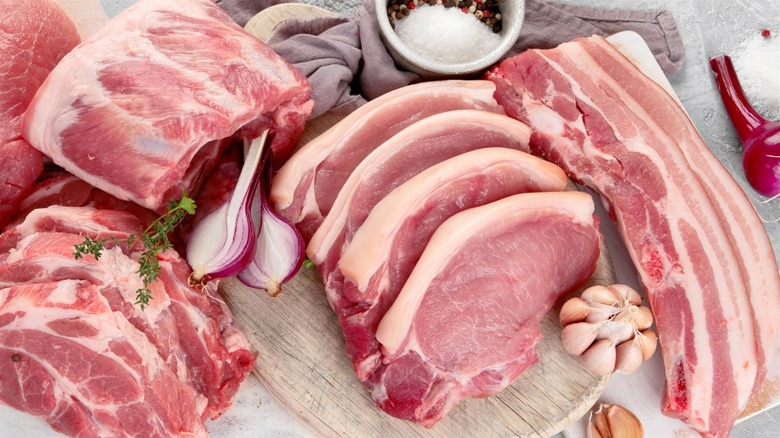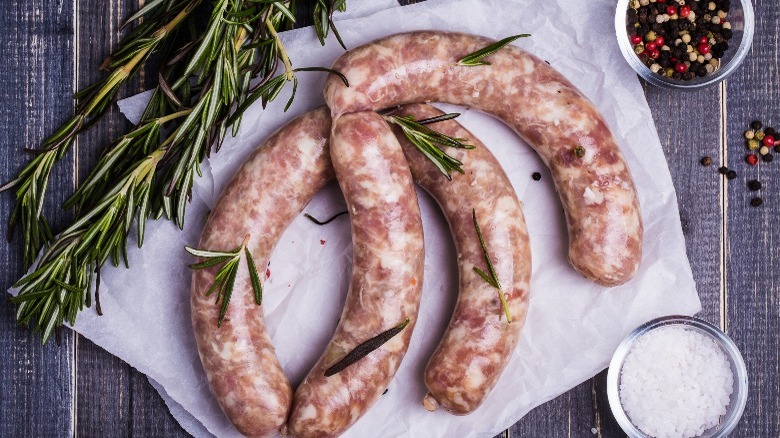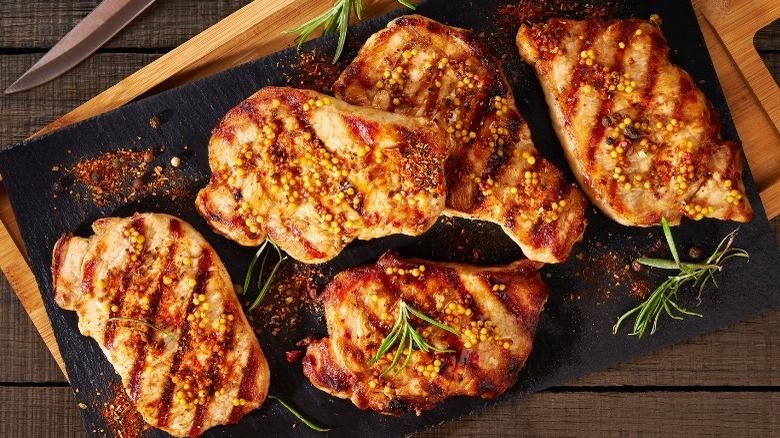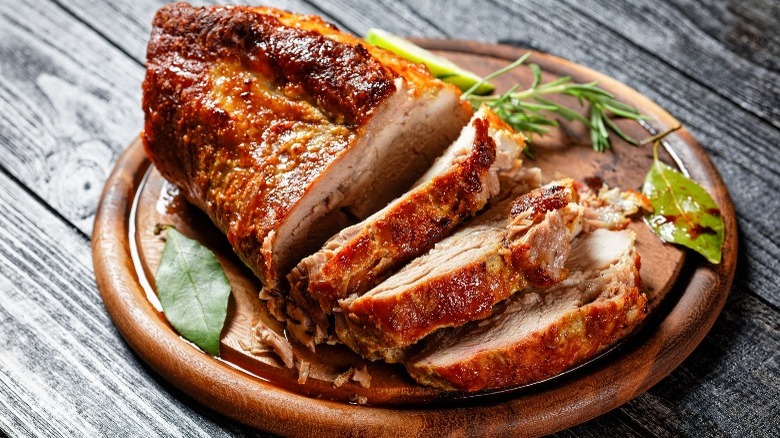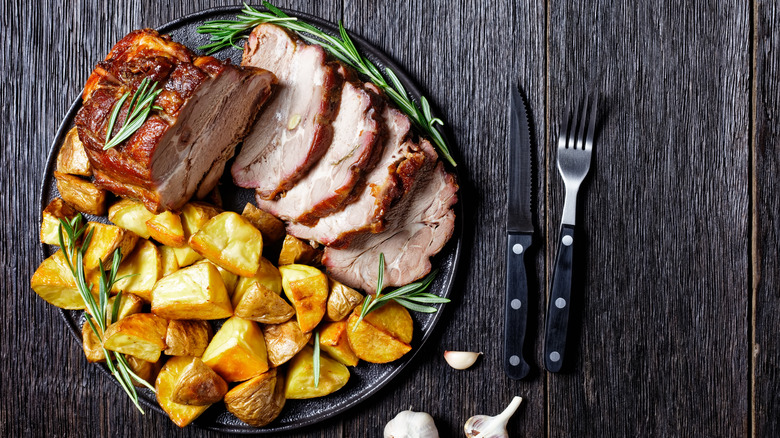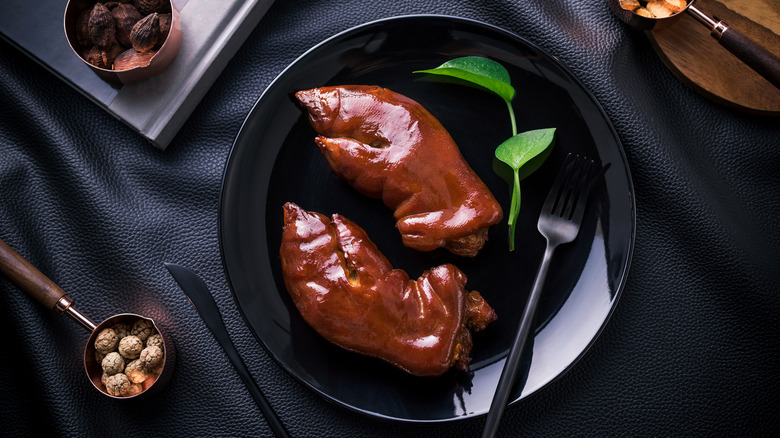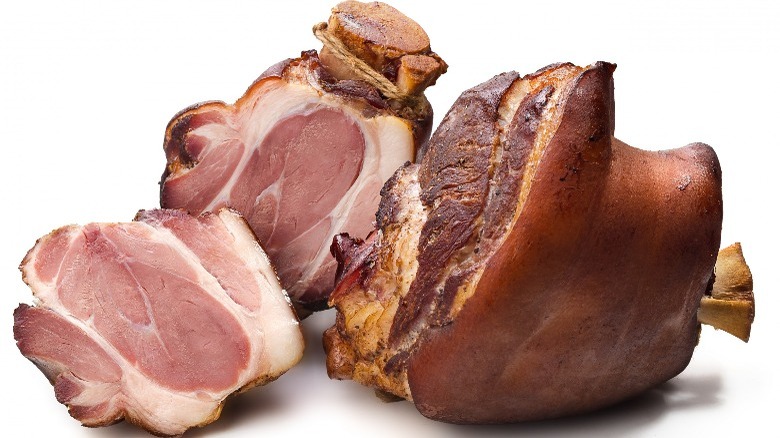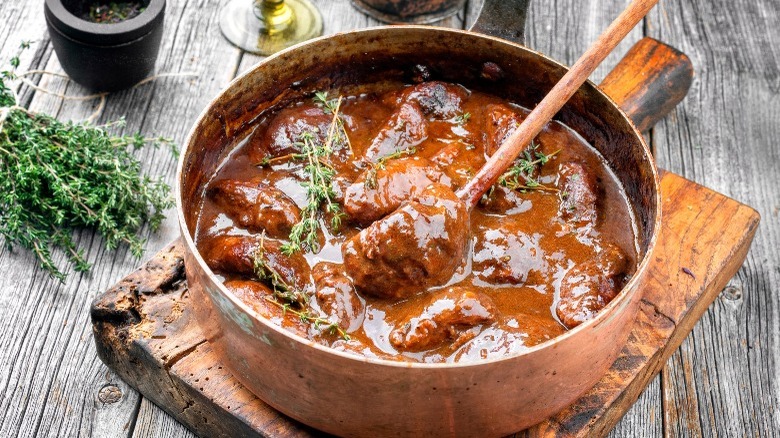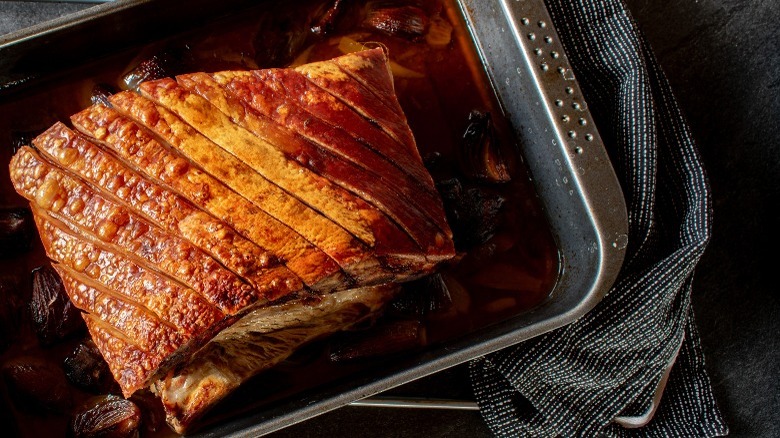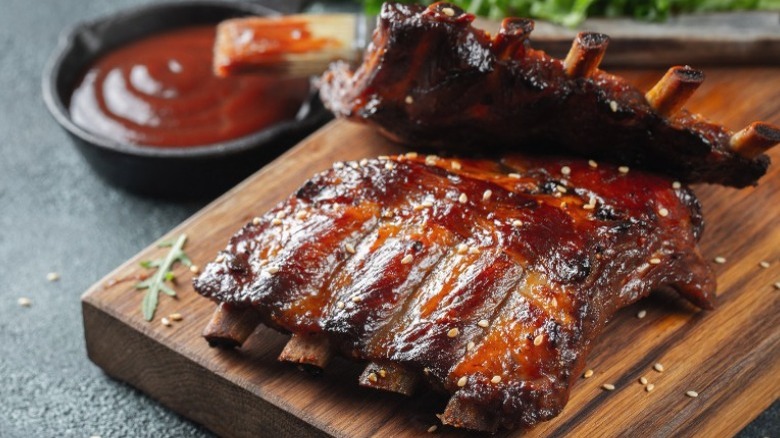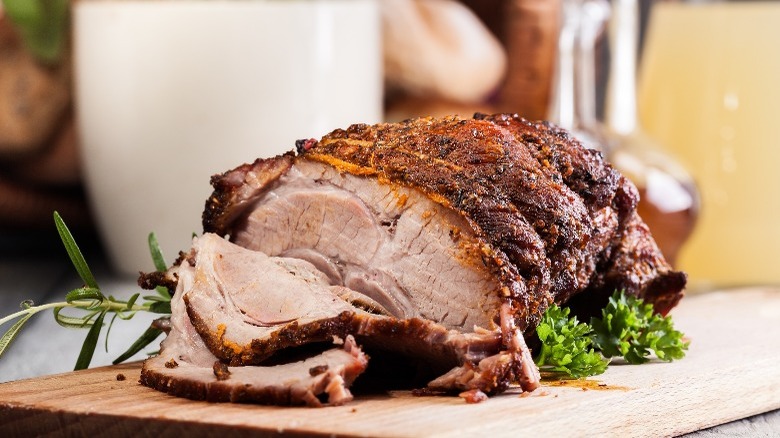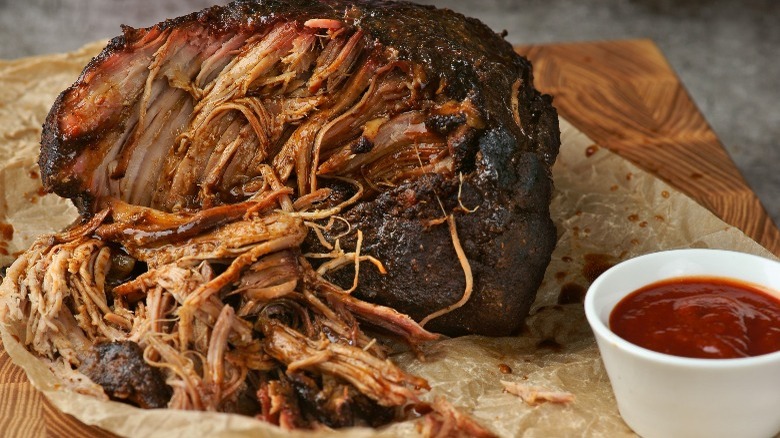Ranking 11 Cuts Of Pork To Slow Cook, From Worst To Best
Experienced chefs and newbie cooks alike can agree on one thing: pork is a master chameleon in the kitchen. What better way to experiment with flavors and textures than with pork? That's because it can be crisped, cured, cooked, and pulled apart, to name just a few of the many techniques suited to this versatile meat. Yet it's still not the top choice for carnivores in the US. In fact, pork is the third-most consumed meat in the United States, according to The Organization for Economic Co-operation and Development, coming in after beef and chicken.
If you're not a fan, consider giving pork a second choice, especially when it comes to slow cooking. With that technique, pork can match the silky texture of some cuts of beef or more delicate chicken. Plus, if you're curious about slow cooking, it's essential to know what meat you're working with. After all, it's sadly easy to grab the wrong cut and end up with paper-dry pork. But when you choose the correct cut? Boy, are you in for a treat!
Now, which cuts of pork should you choose when reaching for the slow cooker or another time consuming method? We did a deep dive into some of the most popular cuts of pork to determine which to toss into your cart and which to skip on your next trip to the grocery store. Keep reading to see our picks for cuts of pork to slow cook ranked from worst to best!
11. Ground pork
Pork sausages are a food found in many different types of cuisines across the world, including German bratwurst, chorizo, salami, and kielbasa. All are made from the ground version of the meat.
Many different types of sausage are just made of ground pork that is seasoned and cased, according to Coleman Natural Foods. So, why not pop it in the slow cooker? After all, a glance at ground pork's ubiquity show that it's already widely agreed upon that sausage is delicious.
It's all because sausage doesn't need to be slow-cooked like some other types of meat. Some sausages arrive already smoked, which is essentially a pre-cook. All you need to do is throw them on the grill or drop them in some boiling water for a few minutes to get them ready for eating. Slow cookers run the risk of overdoing things. What's more, sausage is also usually pretty fatty, thanks to a prevalence of connective tissue. If the part of the animal is used often and bears the animal's weight (for instance, a cut of meat from a pig's legs) then the meat will often be tougher and need more time than other parts to become tender. Sausage often has pieces of fat ground in along with other parts of the pig to provide a tenderness that doesn't need much time to break down. Skip this one for the slow cooker and just get the grill going instead.
10. Pork chops
The pork chop is cut from the pig's loin, which is the area that goes from the pig's shoulder to its midsection. But it gets more complicated from there. According to Kettle Range Meats, there are a few different types of chops that can be sourced from a pig, namely rib, sirloin, boneless, and Porterhouse.
That variety can make things confusing enough, but it's also easy for pork chops to dry out during the cooking process. So wouldn't that make it one of the best cuts of meat to slow cook? But because they're not so fatty, the truth is that pork chops are another cut of pork that do best with a relatively fast cook time. You can get perfectly juicy and moist pork chops from a pan sear or a pan sear plus a quick bake. Slow cooking can still produce an overly tough result.
While they don't rank super high on the list of best cuts of pork to slow cook, we are still fans of pork chops when done right. This cut earns bonus points for being an ultimate go-to weeknight dinner for its super speedy cook time along with a neutral flavor that plays well with other ingredients.
9. Tenderloin
Tenderloin is a thick strip of meat that derives from the section of the pig that runs from its shoulder to its leg, according to Pork.org. This means that it is a lean cut and so, the longer you cook it, the tougher it gets. Pork loin is indeed a delicious cut of meat but it doesn't do well with a low and slow preparation ... well, unless you like tough, chewy meat!
If you need some help keeping your cuts of pork straight, think of tenderloin as pork's answer to chicken breast. Like chicken breast, it's easy to overcook this cut because it's a smaller piece of meat. Indeed, it might even begin to fall apart with too much cooking (and not in a mouth-watering way). Slow cooking, with its long times, simply isn't the way to go with this cut of pork.
If you have a pork tenderloin on hand, you'll want to leverage some moisture-enhancing techniques like brining the meat before cooking. Keep an eye on your cook time, too. Pork.org also suggests aiming for crispness on the surface, which you can confirm by checking that the oven is fully heated before you begin cooking.
8. Loin
This next cut may look familiar, but we promise that it's different! That's because pork loin is a completely different cut than the tenderloin. According to MasterClass, pork loin is thicker than the tenderloin. Pork loin is a wide piece of meat from the pig's midsection. It's lean but it has a fat cap, which adds some much-needed moisture to the cut.
Pork loin doesn't have an overt pork flavor so it's perfect if you're looking for a more neutral type of meat to please picky eaters. This will get tough quickly, however, so you'll need to proceed with caution when using the slow cooker. For best result, make sure that the water level stays high during the cooking process so the meat doesn't dry out. If you've decided to take roast the pork loin instead of using the slow cooker, you'll need to consider your flavors carefully. Luckily for creative cooks, pork loin is a great blank canvas. Iowa Pork suggests using garlic, salt, pepper, and rosemary as seasoning.
7. Foot
Pigs feet are a cut of pork that simply requires slow cooking for best result. According to Cook's Info, if this variety of pork isn't cooked long enough, the connective tissue will remain tough and make the resulting dish virtually inedible. However, this is an unusual cut for some. Because many people have to wrap their minds around the idea before they can get the hang of pig feet, we didn't rank it any higher.
If you're up for a potentially new kind of pork, this cut does have its benefits. Pigs' feet can give off quite a bit of gelatin during the cooking process. This can be good or bad, depending on the type of meal you're making. It helps to set pies and other dishes that need some structure, so you can use pigs' feet accordingly there.
Of course, you could already be familiar with this cut of meat, as it's enjoyed in many parts of the world including the Southern United States, China, and France. And if you're into doing good for the environment, eating pigs' feet is a great way to practice "nose to tail" eating, as per CNN.
6. Shank
Pork shank is one of those cuts of pork that might look intimidating with its massive bone, but never fear! This pork cut is actually quite simple to prepare. This cut is the pig's front forearm, according to Porter Road. It's a tough cut because the pig puts it to good use as it moves around.
Now, that sort of mix of tough connective tissue and muscle are exactly the components that make for a good slow cooking cut, which lands pork shank in the middle of the list. All of that tissue needs to cook down and, with the right conditions and amount of time, the fibers, fat, and muscles will virtually melt back into the meat and broth, creating a luscious texture. You don't want a chewy pork shank, so make sure to give this all the time it needs. A slow braising, for example, is the ideal fate of this cut. It may also be a boon for you wallet. Because pork shank is not the most commonly-used part of the pig, you may be able to find it for a decent price as well.
5. Jowl
As its name suggests, pork jowl is from the cheek of the pig (and you may indeed see it referred to as "pork cheek"). Yummy.ph suggests you use it as a cheaper alternative to pork belly because it's got meat with a signature fat cap.
You may have already had pork jowl as guanciale, the Italian cured version of this cut. While we love slow cooked pork jowl, it works better when chopped and sprinkled over a dish as a garnish. It does taste delicious when slow cooked, but because it makes for a wonderfully unique, carnivorous garnish, we think it works far better in other applications and sodidn't rank it as high as some other types of pork to slow cook. If you insist on bringing out the slow cooker or another time-consuming slow method, we will admit that pork jowl is a delicious cut of meat for this application. It's underutilized and packs in some seriously intense flavor. Just consider some other ways of using it first.
4. Belly
Pork belly might go down in history as one of the best cuts of meat ever. Seriously! It's an incredibly versatile cut of meat that also happens to be quite tasty. Now, most people know pork belly as bacon, which is perhaps the most common way to eat the cut. As suggested by its name, pork belly is indeed cut from the stomach area of the pig. According to MasterClass, there is a large fat cap on this cut of meat that essentially melts into the pork when it's cooked correctly.
Great British Chefs suggests slow roasting this cut, which is one of the best ways to get pork belly's fat to both to render down and then crisp up. You can braise or stew pork belly in addition to oven roasting, so the decision is up to you depending on what mood you're in! Pork belly is virtually untouched when it comes to flavor and downright deliciousness, but we didn't rank it higher on the list because it does get tricky when it's time to get the skin perfectly crispy. It's not too bad if you follow a good recipe step by step, but if you're looking for an easy cut of meat to slow cook, then pork belly might not be the one for you.
3. Ribs
If you've ever eaten freshly cooked pork ribs and licked the sauce off your fingers, then congratulations — you've come as close as possible to heaven on earth! There is something primal and exhilarating, not to mention downright delicious, about eating pork ribs. When cooked up right, they have just the right amount of fat and a fantastic flavor that works well with the rich, sticky sauces often slathered on top of the ribs.
To get your ribs just right while cooking them slowly, Barbecue Bible suggests that you not sauce too early; otherwise, this cut of pork may burn. Instead, apply your sauce within the last five minutes of cooking. Barbecue Bible also suggests buying the meatiest racks of ribs you can find to avoid gnawing on bones. While it technically is possible to overcook ribs, the cartilage and fat mean that they'll need plenty of time on the heat to reach perfection. If you throw them in the slow cooker, plan to cook them on low for at least 8.5 hours for ribs that fall off the bone.
2. Shoulder
This likely won't come as a surprise to anyone in the know, but we've given one of the top spots on this list to pork shoulder. Perhaps best known as the base meat for pulled pork, pork shoulder is just about everything you expect from slow roasted pork. It falls apart, is full of flavor, and is relatively easy to prepare. As its name suggests, pork shoulder (sometimes called picnic roast) is the part of the pig's shoulder just above the front legs (via MasterClass). This is a particularly fatty cut of meat, so it needs quite some cooking time to break the connective tissue down into just the right texture.
Pork.org suggests cooking it for 6-8 hours at a lower setting, or 4-5 hours for higher temperature methods. That may be quite a bit of commitment but, once you've given the fat time to render down, you'll see that pork shoulder is a nearly unbeatable cut of pork. We also love pork shoulder because it works with virtually every type of cuisine. You can pair it with mashed potatoes, eat it with some grilled corn on the cob, toss it into a bowl of Sichuan noodles, or cook it into a ragu and eat it with pasta. It's one of the great multitalented meats of the food world!
1. Butt
In addition to being the best cut for slow-cooking, this cut of pork could also win the title for most misleading name. That's actually good news, though, because pork butt is not made from pig's rear end at all! This cut comes from the front half of the pig above its legs. Pork butt is the cut that sits just above pork shoulder. In many ways, the two cuts are pretty similar. The name derives from a time when butchers used barrels, also known as "butts," to store pork, explains Butcher Box.
There are a few key differences between pork butt and shoulder, as well as key reasons why pork butt is a notch higher than its cousin. In the game of slow-cooking, there has to be a lot of fat and cartilage in a cut for it can break down into something truly delicious. This helps to ensure the meat doesn't just get tough, which is exactly what pork butt brings to the table.
What's more, as fatty as pork shoulder is, pork butt has even more fat, according to BBQ Champs. So, it's even more suited to a slow cooking method, which helps to give you a more tender end product. You can't go wrong with most of the cuts of meat in our roundup, but if you're looking for the most tender, moistest, most exciting cut of pork to cook over a long period of time, then you simply must grab a portion of pork butt.
